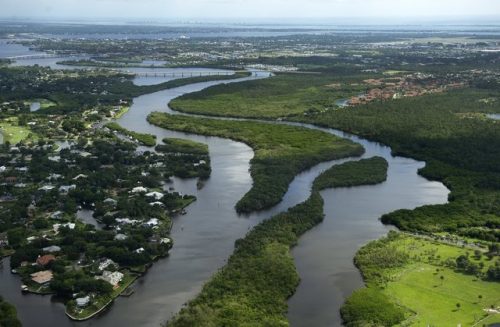Photo: Rosica, Jim. Saint Peters Blog, saintpetersblog.com/tag/apalachicola-chattahoochee-flint-river-basin/.
Entex President & CEO, Wayne Flournoy, discusses the importance of water reuse and Entex’s contributions:
We are seeing increasing signs of water scarcity, even here in the eastern part of the US. Yes, water is a renewable resource, but we can help Mother Nature. And Entex is doing its part.
Until the recent crisis in Flint, MI, most of us take water for granted. We turn on our faucets and inevitably, consistently, clean water comes pouring out. While the Flint crisis was a shot across the bow, most still put little thought into how we get clean water and how our wastewater is treated and returned back to nature. Water requires good engineering and proper management as it is not unlimited.
The recent Supreme Court case between Georgia and Florida on their dispute over access to the waters of the Apalachicola-Chattahoochee-Flint River basin is yet another reminder of the growing scarcity of water, not just in the arid western states, but all across America. This basin currently provides 70% of Atlanta’s water and is an important resource for southern Georgia farmers, but Florida isn’t happy. This isn’t the first dispute over water for Georgia. They’ve had a long-standing argument with Tennessee over access to the Nickajack Lake, where a survey error over 200 years ago deprived Georgia of access to the waters by just a mile. That dispute is called the “Water Wars” .
The more famous “Water War” was portrayed loosely by the Jack Nicholson/Fay Dunawaye movie “Chinatown”, which described the shenanigans behind the construction of the Los Angeles Aqueduct and the resulting water grab that enabled the city’s growth from a small desert town to today’s leading metropolitan area. These events occurred in the early part of the 20th century.
And water scarcity is expanding. John Wesley Powell first reported in 1878 on the arid lands of the American west that began approximately mid-way across the continent. That line between the arid west and the lands to the east with relatively abundant water came to be called the 100th Meridian. However, it turns out that this line seems to have moved east by about 140 miles since 1980. It currently is closer to the 98th Meridian than the 100th.
Despite the occasional drought and the ensuing water restrictions and the disaster in Flint, most of us take clean water for granted. After all, don’t we live on the water planet with 70% of the surface covered by water? It turns out that less than 3% of that water is fresh water. And here’s the kicker, about 2/3rds of that is locked up in glaciers and snow packs, leaving only a small fraction available for ready use.
Americans use about 160 gallons a day per person. This is interesting, since it’s estimated that the actual needs to sustain life are closer to 12 gallons per day. And then there’s agriculture. It turns out that about 75% of the withdrawals from our 96 fresh water basins go to irrigation. We are heading for serious problems unless we make some adjustments.
Conservation is one area where we have made significant progress. Gone are the days where I would drive through the west and see spray irrigation of highway cloverleafs as they grew flowers in the desert. Simple changes like low flow toilets and showerheads have had impacts as well.
Some 30 years ago as I watched some of the first wastewater reuse efforts being initiated in California and the west, I spoke with an east coast water resources manager. I was curious if he saw those kinds of efforts being contemplated back east. Yes, he said. Its already here. Every town on the Chattahoochee builds its drinking water plant upriver of the town and their wastewater plant downstream. The river, he said, is just a wide spot in the recycle process as the distance between the downstream wastewater plant and the upstream drinking water plant gets closer and closer every year.
More recently, Entex has contributed directly to wastewater reuse. At Emory University in Atlanta, the wastewater from the University is treated using Entex’s Webitat system and reused in chillers and cooling towers. A similar system near Wilmington, NC uses Entex’s Webitats in the same way. These two water reuse facilities cleverly disguise the wastewater treatment operations under large plant growths inside a greenhouse. We’re pleased to contribute to helping nature reuse water as a renewable resource.

Yes, that’s our Webitat under those plants!
As we grow our population and continue to increase population densities, we need to help Mother Nature with her renewable resource of water by treating water and finding useful and socially acceptable ways of applying wastewater reuse. Entex began its mission over 15 years ago by applying innovative technologies to the growing need to clean water. Some 70 installations later, we continue to look for new ways to Engineer Clean Water Solutions.
